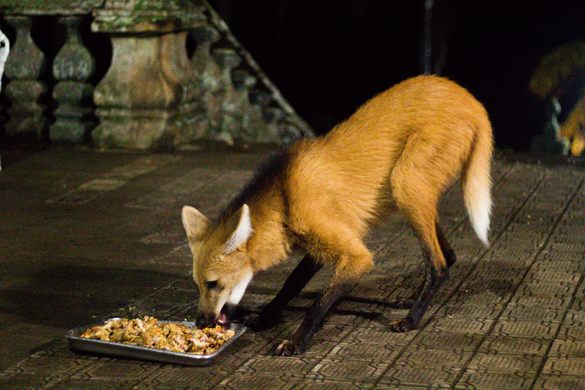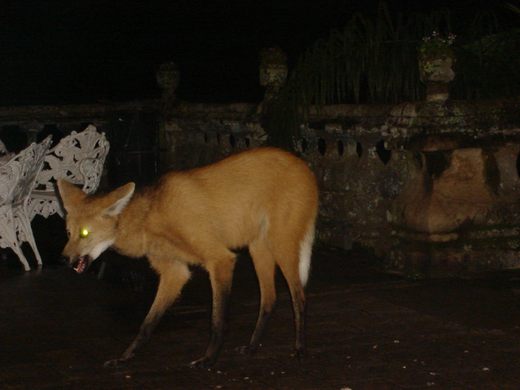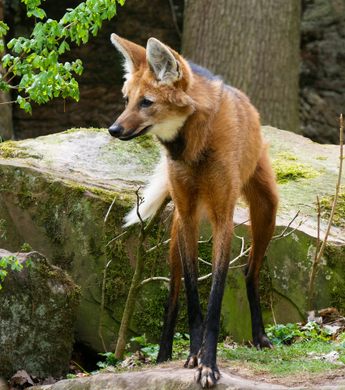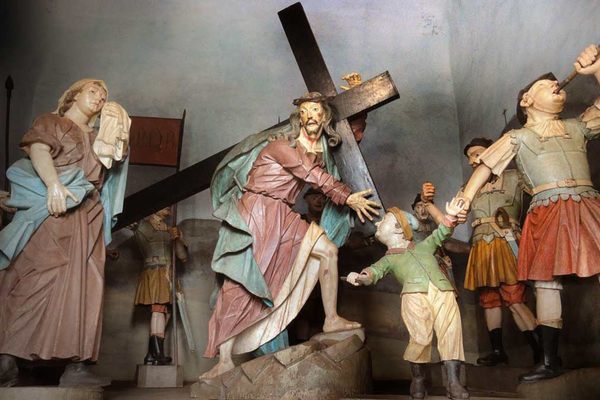Maned Wolves of Santuário do Caraça
This neo-Gothic monastery offers a rare chance to witness the unique maned wolf right up close.
Sitting under the night sky on the steps of this atmospheric neo-Gothic monastery, you may witness the beauty of the maned wolf at extremely close quarters. For those lucky enough to encounter one of these rare creatures, it’s a surreal and unforgettable experience.
The unique relationship between the residents of the Santuário do Caraça monastery and the area’s native maned wolves began in the early 1980s. Monks started to notice that an apparently large and strong animal was habitually raiding the church’s trashcans by tipping them over and dragging out the contents for clandestine midnight feasts.
Eventually, an intrigued and somewhat frustrated seminarian decided to wait up during the twilight hours of the morning to find out what was causing the mess. To his surprise, he encountered a tall and lanky canine creature with red fur, the gait of a deer, and Mickey Mouse-like ears, chowing down on kitchen scraps in the church courtyard.
The animal was a maned wolf, which, despite the name, is not an actual wolf. In fact, the unique animal more closely resembles a fox with very long legs and is the tallest wild canine. The maned wolf is a primitive canid species native to South America, which early Iberian colonists thought resembled the wolf of the Old World. But unlike the fierce North American and Eurasian wolves that occasionally make humans their prey, the maned wolf is a shy and inoffensive creature incapable of hunting large prey, feeding mainly on fruit and rodents.
Partly to enjoy the spectacle of this strange creature, and partly in order to stop the nightly rubbish bin banditry, the monks began to leave scraps of meat out in the open. This tradition has now taken place every night for the last 30 years. Generations of maned wolves have served an important role as ambassadors for their species, as sightings by visitors help increase awareness about protecting these threatened animals and conserving their habitat.
Nowadays the monks feed the maned wolves of Caraça with a specially formulated and balanced meal that has been suggested by zootechnics, vets, and conservation biologists. Subsequent studies conducted by ecologists have shown that this does not negatively impact or alter either their natural behavior or ecological function in the wild. Needless to say, these are not “trained” or “tame” animals, and their wildness has always been respected.
As a visitor, you can make a pilgrimage to this 17th-century monastery and spend the night sitting on the steps of the church beneath the stony eyes of a sculpture of the Virgin Mary, watching the antics of these beguiling creatures as they feed on the terrace under a starry sky.
Know Before You Go
The best way of getting to Santuário do Caraça other than by car is by first heading to the town of Santa Barbara, which can be reached by taking a relatively comfortable "oni-bus" from the bus terminal of the city of Belo Horizonte, capital of Minas Gerais state. (It may take a little over two hours by bus to get to town depending on traffic.) Once you have arrived in Santa Barbara a taxi ride up to the winding roads up the hills to the Santuario will set you back 50 to 60 Reias.
Please be respectful to the wolves by following the advice of the church, and not disturbing the animals with unnecessary loud noises, sudden movements, or attempting to touch them, as they are animals susceptible to stress. Also please be respectful of the historic surroundings of the monastery and the people living and working there, who do a fantastic job at conserving this wonderful site, its natural areas, and its wildlife.



















Follow us on Twitter to get the latest on the world's hidden wonders.
Like us on Facebook to get the latest on the world's hidden wonders.
Follow us on Twitter Like us on Facebook